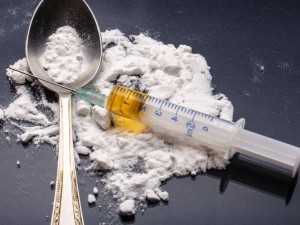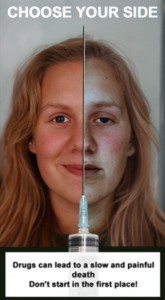Heroin is no longer a private activity. Residue from users can be seen anywhere, in parks, on the streets, even on public transportation. A serious threat is being imposed on society and unfortunately it seems more people are supporting it rather than trying to fight it.
Heroin is becoming a very popular new trend in today’s society. The drug is cheap, highly addictive, and becoming increasingly available. Heroin addiction often starts from an original addiction to opiates, or painkillers. People are 40 times more likely to be addicted to heroin if they are addicted to prescription painkillers (US NEWS). In the nineteenth century, physicians played a major part in addiction, by using morphine and opium to cure common symptoms, unintentionally turning their patients into addicts (Unick, George Jay).[1] However, most of their patients were white upper, to middle class users, which supports the fact that prescription painkillers were not cheap. The steep cost is what makes users shift to heroin because they get a very similar high for a much lower price.
An estimated 13.5 million people in the world take opioids, or opium-like substances, including 9.2 million who use heroin (DRUG FREE WORLD). There has been a major increase in heroin use within the past decade. The rate of heroin-related overdose deaths increased 286 percent between 2002 and 2013 (US NEWS).
Despite what many people believe, heroin does not discriminate. It affects all ages, genders, classes, locations, and races. In fact, there has been a large increase among heroin use and young white males. Large metropolitan areas are said to be at the highest risk for heroin use, however now a lot of attention is being placed on white suburbs as they are becoming a problem area.
Although heroin is an illegal drug, it is becoming more and more public and its residue can be seen in many places. A video was posted on Youtube, on April 5th, 2015, of a young man shooting up while riding a city bus in Philadelphia, in full view of other passengers.
Since heroin is so cheap and so widely available, users are buying more often and shooting up as soon as they can, often in public places. In Cambridge, Massachusetts, the city had to close the bathroom of a historic church that was open to accommodate homeless people, because several people had overdosed in them (NY TIMES).
The reason for the public use of heroin addicts may be partially related to the root cause of the addiction, which is legal opioid painkillers. In many different places, such as Linthicum, Maryland, Cincinnati, Niagara Falls, and Johnstown, Pennsylvania, addicts have been found in public restrooms, often in fast-food chains, overdosed, sometimes with the needles still in their arms (NY TIMES).
There have also been public views of addicts overdosing and then being revived by Narcan, which reverses the effects of heroin. In 2014, about 125 Americans died everyday due to overdose (NY TIMES). The death rate from overdose is increasing at a much faster rate than other causes of death.
Along with the public use of heroin, is the increase in safety hazards in everyday life. After shooting up, addicts often leave behind dirty needles and syringes wherever they injected. In a documentary titled Heroin in America, by David Muir on ABC News, groups of young children were asked if they had ever seen needles or been exposed to other paraphernalia before. All of them raised their hands and said that they have seen them while walking down the street, or lying in the grass at the park. With dirty needles lying around everywhere, it is very dangerous for society. So many diseases can spread if the needles were touched accidentally, and children should not be exposed to or have to worry about these things while walking to school or playing outside.
The best way to put an end to this would be to stop the supply of heroin all together. However, that may be a little unrealistic. Heroin is so highly addictive that it those who are under its control will do anything to get it.
Opioids and heroin affect the brain in the same way. They increase the amount of dopamine that is released in the limbic system of the brain, which creates intense pleasure. The pleasure is so strong that people become physically and psychologically dependent on the drug. The drug also takes over other parts of the brain, such as the systems that drive judgment, planning, and organization. These areas now encourage using the drug and the brain serves to people’s addiction (NPR). This all happens so fast that people become highly addicted with their first use.
The things addicts will do when they are in need of heroin cannot be underestimated. Heroin affects peoples judgment and decision making so much that users may do things they never thought they would do in a million years.
Some users anonymously posted about their lives as junkies, how fast the drug took over, and how ashamed they were of the things that they have done:
“From the day I started using, I never stopped. Within one week I had gone from snorting heroin to shooting it. Within one month I was addicted and going through all my money. I sold everything of value that I owned and eventually everything that my mother owned. Within one year, I had lost everything.”
“I sold my car, lost my job, was kicked out of my mother’s house, was $25,000 in credit card debt, and living on the streets of Camden, New Jersey. I lied, I stole, I cheated.”
“If anything, death was better than the a life as a junkie” (DRUG FREE WORLD).
Supervised-injection facilities are a suggested new form of treatment for the epidemic. These facilities aim to decrease the amount of overdoses and ensure the use of clean needles and other paraphernalia. Instead of rejection and exclusion, this approach suggests that a lot of the harm caused by drug use could be reduced with decriminalization, education, and the provision of clean needles.
This is silly because it basically supports the normalization of illicit drug use. Drugs, especially heroin, are causing so many tragedies in our country that people should want to put an end to them. However, by believing that it is okay to do drugs as long as you practice them safely is just maintaining the epidemic. This approach allows users to shoot up whenever they would like and does not show any of the consequences of using drugs.
The most beneficial form of treatment for heroin and opioid addiction would be specialized rehabilitation centers specifically for heroin and opiates. These drugs are so strong and affect people differently than any other drug. “Treatment for opioid addiction includes a variety of services: medication, talk therapy, job support, all stretched out over years. Detox is not enough” (NPR).
These rehab centers should also be more proactive in wanting to really help heroin addicts. Tracey Helton Mitchell, a certified addiction specialist, who was once a heroin addict, describes today’s treatment centers as a “one-size-fits-all” approach. She believes society needs to “have a variety of different kinds of treatment interventions that address people’s needs” (NPR). We need to stop grouping addicts together and try to reach out to them as individuals and help them based on their unique needs and motivations.
Before these changes can happen, society needs to drop the stigma around addiction. Many intervention agencies deem heroin addicts as powerless and incapable of reason and self-control. Treating people as if they have no chance of getting better will make them lose all hope and will to even try. In no way should addicts be praised, but they should be treated like everyone else. Heroin is a drug that can affect everyone. Like I stated earlier, it does not discriminate based on race, age, gender, or class, and it works so fast that it only takes one time to be addicted for life. Once people start treating addicts as individuals and not as a “troubled group” a lot of self-respect, rational subjectivity, and autonomy will be restored among addicts, and hopefully the addiction rates will decrease.
The last thing I believe will help put an end to the heroin addiction that is sweeping the nation, is truly educating people of all ages about the dangers of heroin.
Other than a health class in sixth and ninth grade, I have never really been exposed to much information about heroin. I learned that it was bad and illegal but a lot of drugs people use are bad and illegal. However, those other drugs do not affect people’s lives even a quarter as much as heroin does. If people were really submerged and saw how heroin changes almost every aspect of a person’s life and how they become completely dependent on it, it would make society, especially the youth, realize that heroin and opioids are not something to mess around with.
As simple as it seems, it could really be effective in reducing heroin addiction rates within the United States.
Putting an end to heroin and trying to reduce addiction is something that needs more attention and more support. With the way it has increased in the last decade, let alone the past couple of years, I am scared to see what the future will be like if nothing changes. People need to start now otherwise in the upcoming years there will be more supervised-injection facilities than McDonalds restaurants.
[1] Unick, G. J., Rosenblum, D., Mars, S., & Ciccarone, D. (2013). Intertwined epidemics: National demographic trends in hospitalizations for heroin- and opioid-related overdoses, 1993-2009. PLoS One, 8(2) doi:http://dx.doi.org/10.1371/journal.pone.0054496
Reflection
- I think that my topic alone is something that people are very curious about and are interested to read about. I tried to be very gripping with my title and lede by using the word “epidemic” and informing readers that something big is affecting society and that it is very serious.
- My introductory section does a good job with exigency because it talks about today’s society and how people are being affected by heroin, whether they are the ones using or just bystanders. It also talks about the increase in numbers from past years to today.
- I reiterated my main idea multiple times throughout my article. Each paragraph, whether I was talking about statistics, the background of heroin addiction, or ways to prevent it, I supported my main idea and used sources as well.
- I think I did a really good job organizing my piece. I went through everything I wanted to tell the reader and put it together so it flowed nicely and made most sense.
- I think that when writing this piece, I read through my research and the stance I took on the topic, and really thought about and tried to address counter arguments in my article. I tried to fully develop my point of view and support it completely.
- I looked through a lot of sources when researching my topic. I wanted to make sure I was very informed and the information was accurate. I connected the research I found and used it to help support my stance and show flaws in other counter arguments.
- I used many sources in my article to provide statistics and expert’s views and opinions. I relate some of the views of different sources to show how others support my point of view as well.
- I used sources at good times when I was trying to make a point and a source supported that and provided reason behind why people feel that way and why it is a good point of view.
- I think I used ethos, logos, and pathos, well. I tried to connect to the audience through pathos the most because I tried to make the reader see how heroin can ruin your life. I provided examples and quotes from heroin addicts describing how they feel about being a junkie and showing how dependent they are on the drug.
- I used multiple visuals in my article. I used a lot of graphs showing the differences in people and places that have the most heroin users. I also used another graph showing the amount of deaths from heroin in each state from 2003-2014. The visual I thought was most effective was the video of the heroin addict shooting up on a public bus. This video made me sick to my stomach when I watched it and I think it will have the same effect on others.
- I think my final article is a million times better than any of my drafts. When I first started this assignment I was not really sure where to go with it or how to fit all my information in in an organized manner. Each draft was more organized, and I think my final article is very well organized and full of information.
- I used hyperlinks to immediately direct readers to the full articles and videos I used for my article. It allows the reader to get more knowledge and read other interesting articles on the topic as well.
- I think I did a good job with grammar, style, and usage. I tried to sound very credible by making sure my writing was for a more mature audience.





